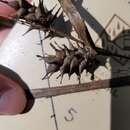Description
provided by eFloras
Plants loosely colonial, long-rhizomatous. Culms erect, 20–75 cm. Leaves 4–10; basal sheaths reddish to brownish; sheath of the distal leaf 2–10 cm; ligules rounded to triangular, 2–7 mm; blades 10–40 cm × 2–6 mm. Inflorescences 10–42 cm; peduncles of proximal spikes 0.5–10.5 cm, basal 2 peduncles 2–10 cm apart; of terminal spike (3–)6–18 cm, exceeding the distal pistillate spike by 2–12 cm; bracts leafy, sheaths 0.5–5 cm; blades 10–30 cm × 2–4 mm. Spikes: proximal pistillate spikes 1–3(–4), separate, 10–30-flowered, ovoid, 1.5–4.5 cm × 1.5–3 cm; terminal staminate spike 1, 0.5–7 cm × 2–3 mm. Pistillate scales 3–7-veined, lanceolate-ovate, 4.5–6.5 × 1.5–2 mm. Anthers 3, 3–4.5 mm. Perigynia narrowly ovoid, 10–14 × 3.5–6 mm, shiny, glabrous; beak conic, 4.5–7 mm. Achenes broadly stipitate, rhomboid, flat faces, angles thickened, 2.5–3.5 × 1.7–2 mm; style same texture as achene.
- license
- cc-by-nc-sa-3.0
- copyright
- Missouri Botanical Garden, 4344 Shaw Boulevard, St. Louis, MO, 63110 USA
Distribution
provided by eFloras
Ala., Ark., Del., Fla., Ga., Ill., Ind., Ky., La., Md., Miss., Mo., N.J., N.C., Ohio, Okla., S.C., Tenn., Tex., Va.
- license
- cc-by-nc-sa-3.0
- copyright
- Missouri Botanical Garden, 4344 Shaw Boulevard, St. Louis, MO, 63110 USA
Comprehensive Description
provided by North American Flora
Carex louisianica L. H. Bailey, Bull. Torrey Club 20: 428. 1893
" Carex turgescens Torr." Dewey, Am. Jour. Sci. II. 3: 356. 1847.
Carex Halei Carey; Chapm. Fl. S. U. S. 543. 1860. (Type from Florida, as given below.) Not
C. Halei Dewey, 1846. Carex Halei var. minor Boott, 111. Carex 94. 1860. (Type from the southern United States.) Carex Eggertii L. H. Bailey, Bot. Gaz. 21: 6. 1896. (Type from Butler County, Missouri.) Carex grandis var. Helleri L. H. Bailey, Bot. Gaz. 21:7. 1896. (Type from Franklin County, Virginia.)
Culms one to few together from slender elongate rootstocks, long-stoloniferous, the stolons slender, horizontal, numerous, the culms 2-6 dm. high, rather slender, exceeded by the upper leaves and bracts, phyllopodic, sharply triangular, smooth, purplish-red-tinged at base, the dried-up leaves of the previous year conspicuous; leaves with well-developed blades 3-10 to a fertile culm, septate-nodulose, the lower somewhat clustered, the upper regularly disposed, the blades thin but firm, dull-green, flat with slightly revolute margins, usually 1-3 dm. long, 2-6 mm. wide, very rough toward the apex, especially on the margins, the sheaths hyaline ventrally, concave at mouth, the ligule longer than wide; staminate spike solitary, on a long, slender, slightly roughened peduncle 3-10 cm. long, the spike narrowly linear, 1.5-6 cm. long, 2.5 mm. wide, the scales linear-obovate, acute or acuminate, straw-colored with 3-nerved green center and hyaline margins; bracts short or obsolete; pistillate spikes 1-4, not aggregated, the lowermost especially often widely separate, the upper short-peduncled, the others on smooth peduncles from shorter than to several times as long as the spike, the spikes oblong or broadly oblong, 2-3.5 cm. long, 1.5-2.5 cm. wide, densely flowered, the perigynia 10-30, ascending, in about six rows; bracts leaf -like, exceeding inflorescence, strongly sheathing, short-prolonged and convex at mouth; scales ovate or lanceolate, acute or acuminate, strawcolored with green several-nerved center and hyaline margins, much shorter and narrower than the perigynia; perigynia ovoid, 10-13 mm. long, 4-6 mm. wide, suborbicular in crosssection, strongly inflated, submembranaceous, smooth, dull-green, straw-colored at maturity, strongly about 20-ribbed, round-truncate at base, sessile or nearly so, contracted into a smooth or minutely roughened, conic, bidentate beak nearly half as long as the body, the teeth 0.5-1.5 mm. long, slender, stiff, erect or somewhat spreading, smooth or nearly so within; achenes ovoid or obovoid, 2.5-3 mm. long, 2 mm. wide, much longer than wide, triangular with shallowly concave sides and slightly thickened angles, loosely enveloped, brownish, tapering at base, broadly stipitate, contracted into and continuous with the strongly bent, slender, persistent style; stigmas 3, slender, blackish, short.
Type locality (of C. Halei Carey, on which C. louisianica is based) : " Banks of the Apalachicola River, Florida and westward. (Specimens collected in Louisiana by Hale are taken as the type.)
Distribution: Swampy woods, acid soils, Florida to Texas, and northward in the Mississippi Valley to southwestern Indiana and east of the mountains to New Jersey. (Specimens examined from New Jersey, District of Columbia, Virginia, North Carolina, Georgia, Florida, Alabama, Mississippi, Louisiana, Texas, Arkansas, Missouri, Kentucky, Indiana.)
- bibliographic citation
- Kenneth Kent Mackenzie. 1935. (POALES); CYPERACEAE; CARICEAE. North American flora. vol 18(7). New York Botanical Garden, New York, NY
Carex louisianica: Brief Summary
provided by wikipedia EN
Carex louisianica, commonly called Louisiana sedge, is a species of flowering plant in the sedge family. It is native to North America, where it is primarily found in the southeastern United States. Its natural habitat is wet, swampy forests and openings.
It is a rhizomatous perennial that flowers in spring. It produces fruits in late spring and summer.
- license
- cc-by-sa-3.0
- copyright
- Wikipedia authors and editors

